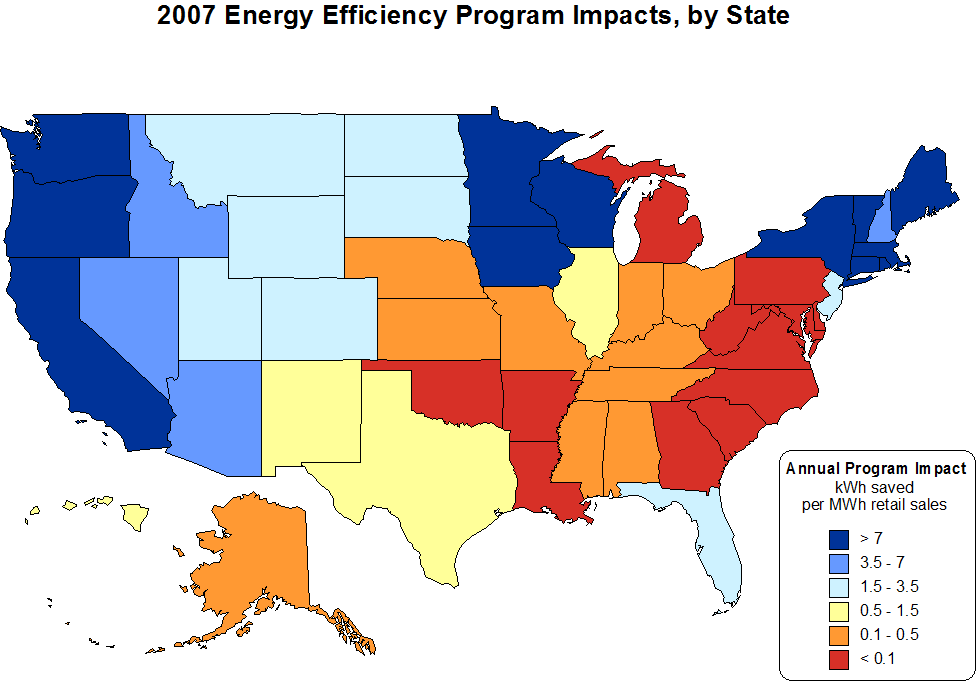With less fanfare than you might expect, state governments and utilities in the Carolinas have moved forward on energy efficiency. In total, we estimate that these programs could reduce electricity demand by about 8% in 2020.
| Cumulative Impacts | Total | North Carolina | South Carolina | Duke Energy | Progress Energy |
| 2009-2020 | New Efficiency Initiatives | Efficiency Building Codes Update | Efficiency Building Codes Legislation | Save-a-Watt Agreement | Announced Programs |
| Energy Savings (GWh) | 93,531 | 30,046 | 25,078 | 34,164 | 4,243 |
| Cost Savings | $ 2,853,447,165 | $ 342,600,000 | $ 1,089,789,809 | $ 1,264,076,272 | $ 156,981,084 |
| Net Jobs in 2012 | 3,792 | 2,012 | 623 | 1,056 | 101 |
| Global Warming Pollution Avoided (Million Metric Tons CO2e) | 72 | 21 | 22 | 26 | 3 |
(Data related to building codes are derived from recent state climate planning studies (NC, SC). Data related to utility programs are SACE analysis of impacts using assumptions from the same climate planning studies and jobs data from ACEEE.)
Congratulations to those whose efforts paid off with major improvements to state building codes in North and South Carolina. Although the scale of Progress Energy’s programs are disappointing, it is a start. We are also very excited about the potential for approval of the Duke Energy Save-a-Watt program very soon.
South Carolina Building Codes Legislation
H. 3550 by Representative Harry Cato (R-Greenville) and others is law. Thanks to the leadership of legislators and the Governor, and with the support and persistent efforts by many organizations, especially the Coastal Conservation League, North American Insulation Manufacturers Association, and the Electric Cooperatives of South Carolina. The new law (see CCL’s fact sheet, pdf) deletes outdated energy standard language from state law and establishes the 2006 International Energy Conservation Code (IECC) as the state energy standard for residential construction and renovations.
North Carolina Building Code Update
The North Carolina Building Code Council adopted a residential and commercial building code update in January. Leaders such as Governor Mike Easley ensured that North Carolina’s historic support for efficiency codes was included in this update.
 Duke Energy and Progress Energy – New Efficiency Programs
Duke Energy and Progress Energy – New Efficiency Programs
As illustrated to the right, utility energy efficiency programs in the Carolinas failed to achieve any significant impact in 2007. Our recent report explains why. But when 2009 data are reported, we hope to see some improvement!
As we announced last week, Duke Energy agreed to a modification to its Save-a-Watt energy efficiency program that mean more energy savings, but with costs and earnings limitations that make it fair to customers. (Note that the data in this blog post use somewhat more conservative assumptions about the benefits of energy efficiency in order to be consistent with the other estimates. The higher values in the original estimate are more consistent with the way we believe energy efficiency benefits should be estimated.)
The recent approval of Progress Energy’s energy efficiency rates by regulators in North and South Carolina is a disappointment. We opposed their proposal because the utility offered small programs but asked for a large profit rate even for those paltry results. Progress Energy’s efforts are so rudimentary that it is actually difficult to determine what they hope to accomplish over the next decade – we’re probably being pretty generous in our estimates here. In contrast, Duke Energy has agreed to a performance-based earnings targets that means it must achieve great results in order to receive strong profits.
Taken together, we can expect cumulative savings of 93,531 GWh through 2020, saving customers over $2.8 billion, and employing nearly 4,000 people in the two states by 2012 (with that number likely to increase throughout the decade).
Furthermore, reducing global warming pollution by 72 million tons over the next decade represents a 2% reduction in emissions over the decade. Based on recent forecasts of 2020 global warming pollution from North Carolina (250 million tons) and South Carolina (170 million tons), these programs could lead to lasting reductions in annual emissions of 5% per year in the following decade.
SACE can’t take sole credit for any of this, really the only one of these initiatives that we helped lead on was the Duke Energy agreement. But it is also important to point out where others have gotten it right!
More leadership needed!
More jobs, cost savings, and mitigation of global warming pollution: What’s not to like?
Unfortunately, Congress isn’t taking full advantage of these initiatives. While the proposed legislation has great new codes and standards provisions, the original proposal to include a 15% energy efficiency resource standard has been diluted to the point that it may result in very little energy efficiency.
While Duke Energy has stepped forward with a strong energy efficiency offering (finally!), other utilities in the Carolinas are holding back. Call your Senators and Representative to push for stronger energy efficiency provisions.
The Carolians and the Southeast have a tremendous opportunity to do more with less through energy efficiency. We’re glad that utilities and public officials in the Carolinas are taking additional steps down that road and look forward to supporting additional opportunities to capture wasted energy while generating consumers savings, creating new jobs and reducing global warming pollution.

